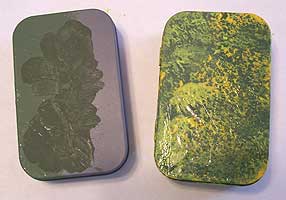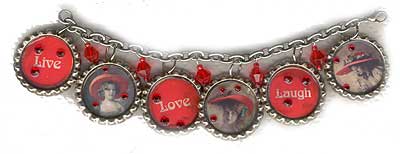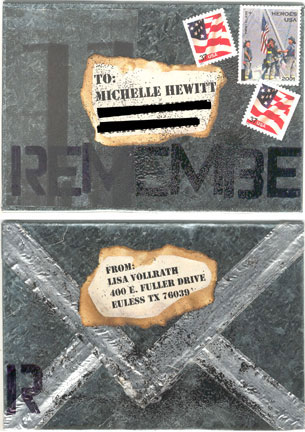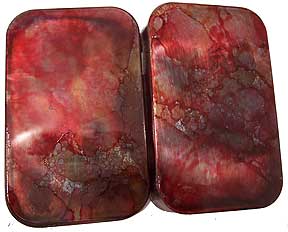 Last month, I told you how I prep my metal tins to be altered. This lesson will show you one way to get some sheer color onto them, without adding bulk that will keep them from closing. This is a variation of the technique usually referred to as polished stone.
Last month, I told you how I prep my metal tins to be altered. This lesson will show you one way to get some sheer color onto them, without adding bulk that will keep them from closing. This is a variation of the technique usually referred to as polished stone.
You’ll need:
- Tins or other metal surfaces. These should be bare, with no coatings or paint on them. My burnt Altoid tins worked great. So does bare metal flashing from the hardware store. The non-plastic coated side of bottle caps will take this technique, as will the inner surface of juice lids. I don’t know what’s on the outer surface—some kind of coating that makes the alcohol inks bead instead of lay flat.
- Alcohol inks. I use Ranger Adirondack inks in the little dropper bottles. They come in lots of lovely decorator colors.
- Alcohol Blending Solution, also from Ranger. I have a sneaking suspicion that this is just alcohol in a convenient dropper bottle. If you’re using another brand of inks, use whichever extender is offered with that line.
- An applicator. I have a wood block with a piece of the hook side of Velcro attached to it. On this goes a strip of plain old kid’s felt. It’s cheap and it works. Ranger sells a tool like this with a handle—I’m not sure what the real name of it is, because we always refer to it as Tim’s Tool at the office, because it was designed by Tim Holtz. I think a cotton ball would probably work for this, or a little piece of sponge.
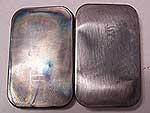 I’m starting with a pair of nicely burned and buffed Altoid tins. There’s no paint left on these—if you need a lesson on how to get them to this lovely metallic state, try this lesson on how to make Altoid tins flambe. These were brushed off with a soft cloth after being burned and scuffed with sandpaper, to remove all the dust and ash.
I’m starting with a pair of nicely burned and buffed Altoid tins. There’s no paint left on these—if you need a lesson on how to get them to this lovely metallic state, try this lesson on how to make Altoid tins flambe. These were brushed off with a soft cloth after being burned and scuffed with sandpaper, to remove all the dust and ash.
 Here’s my handy little felt tool, laying on its back. Onto the felt goes a quick dash of alcohol ink. For these tins, I used Red Currant and Caramel. Any combination of colors that floats your boat is fine. Do a little blob of each color on the felt, right next to each other.
Here’s my handy little felt tool, laying on its back. Onto the felt goes a quick dash of alcohol ink. For these tins, I used Red Currant and Caramel. Any combination of colors that floats your boat is fine. Do a little blob of each color on the felt, right next to each other.
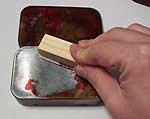 Flip the tool over and pat the inks on the tins. Be blotchy and random about it—don’t worry about getting nice, even coverage. Since this is a textural technique, we’re going to embrace all the weird imperfections along the way. Turn the tool this way and that as you’re patting the color on. If you seem to be drying out, flip the tool back over and apply more ink to the felt.
Flip the tool over and pat the inks on the tins. Be blotchy and random about it—don’t worry about getting nice, even coverage. Since this is a textural technique, we’re going to embrace all the weird imperfections along the way. Turn the tool this way and that as you’re patting the color on. If you seem to be drying out, flip the tool back over and apply more ink to the felt.
If I use this technique on paper, this is where I usually add a few dots of metallic, using a leafing pen from Krylon. Because this is being done on metal, I skipped that step—but if you’d like more fun in your finished piece, do a few dots here and there. They’ll be blended into the inks in the next step. (Psst—Tim tells me that he’s just put the finishing touches on some metallic alcohol inks for Ranger—I’m thinking those will be fabulous in place of the Krylon pen. Watch for them at your local stamp store this fall.)
Alchol inks dry very quickly, so let’s move along…
 Here’s my little tool, back on its back, getting a quick dose of blending solution. This is applied right to the dirty, inky felt. The solution will reactivate any color left on it, adding to the mix.
Here’s my little tool, back on its back, getting a quick dose of blending solution. This is applied right to the dirty, inky felt. The solution will reactivate any color left on it, adding to the mix.
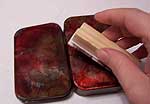 Pat the blending solution onto the inked tin. Watch the colors—they’ll do a sort of sunburst thing as the ink is applied. If you like the pattern, stop patting. If you’d like something a little more blended, pat more. This is a trial and error sort of thing—you can see that my two tins at the top look completely different, even though I did them at the same time. One got very little blending solution, and is really blotchy, which I prefer. One got a little more solution, and is smoother.
Pat the blending solution onto the inked tin. Watch the colors—they’ll do a sort of sunburst thing as the ink is applied. If you like the pattern, stop patting. If you’d like something a little more blended, pat more. This is a trial and error sort of thing—you can see that my two tins at the top look completely different, even though I did them at the same time. One got very little blending solution, and is really blotchy, which I prefer. One got a little more solution, and is smoother.
Let the tins dry completely before you handle them too much. This shouldn’t take too long, even in humid places—let them sit for an hour or so, and they should be ready for whatever else you have in mind. Some folks like to stamp on top of polished stone, or layer transparent images over it. I’m not sure what my tins will get yet, because they’re going to be drawers in an altered book.

